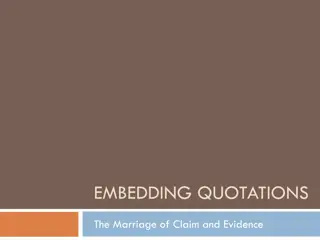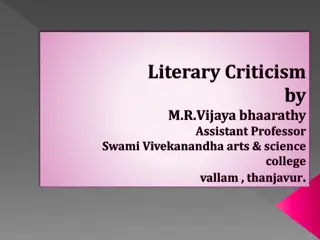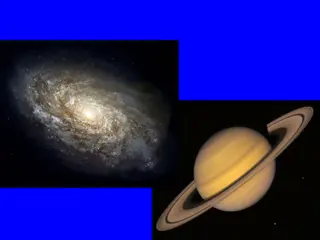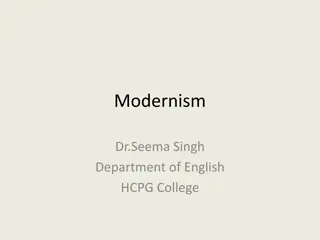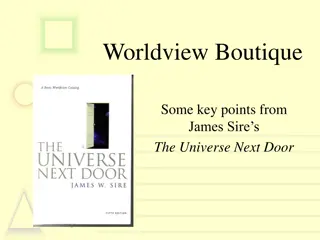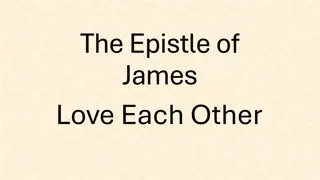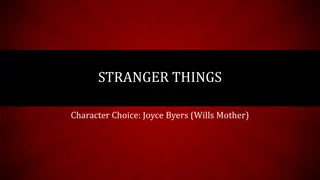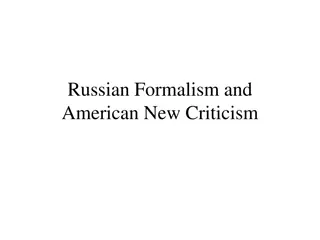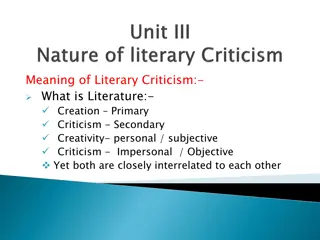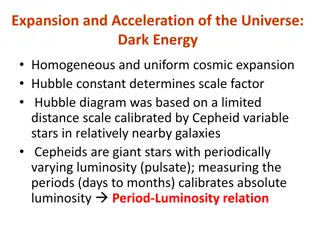The Literary Universe of James Joyce
James Joyce, the renowned Irish novelist, short story writer, and poet, crafted a fictional realm centered around Dublin, populated by characters reflecting individuals from his past. His works, including "Dubliners" and "Ulysses", delve into themes of national identity, epiphanies, and intricate narrative techniques, showcasing the turbulent cultural backdrop of early 20th-century Ireland. Despite his complex relationship with Catholicism, Joyce's intellectual legacy remains profound and influential in the realm of modernist literature.
Download Presentation

Please find below an Image/Link to download the presentation.
The content on the website is provided AS IS for your information and personal use only. It may not be sold, licensed, or shared on other websites without obtaining consent from the author. Download presentation by click this link. If you encounter any issues during the download, it is possible that the publisher has removed the file from their server.
E N D
Presentation Transcript
James Joyce 1882 13 January 1941) was an Irish novelist, short story writer, and poet . Joyce's fictional universe centers on Dublin, and is populated largely by characters who closely resemble family members, enemies and friends from his time there. . My mind rejects the whole present social order and Christianity home, the recognized virtues, classes of life and religious doctrines. [...] Six years ago I left the Catholic church, hating it most fervently. I found it impossible for me to remain in it on account of the impulses of my nature. I made secret war upon it when I was a student and declined to accept the positions it offered me. By doing this I made myself a beggar but I retained my pride. Now I make open war upon it by what I write and say and do. . Some critics and biographers have opined along the lines of Andrew Gibson: "The modern James Joyce may have vigorously resisted the oppressive power of Catholic tradition. But there was another Joyce who asserted his allegiance to that tradition, and never left it, or wanted to leave it, behind him." Gibson argues that Joyce "remained a Catholic intellectual if not a believer" since his thinking remained influenced by his cultural background, even though he lived apart from that culture. His relationship with religion was complex and not easily understood, even perhaps by himself.
Joyce Dubliners is a collection of fifteen short stories by Joyce, first published in 1914. They form a naturalistic depiction of Irish middle class life in and around Dublin in the early years of the 20th century. The stories were written when Irish nationalism was at its peak and a search for a national identity and purpose was raging; at a crossroads of history and culture, Ireland was jolted (shaked) by converging ideas and influences. The stories centre on Joyce's idea of an epiphany: a moment when a character experiences a life-changing self-understanding or illumination. In A Portrait of the Artist as a Young Man (1916), Joyce frequently employed in later works, such as stream of consciousness, interior monologue, and references to a character's psychic reality. Joyce published only one play, Exiles, begun shortly after the outbreak of the First World War in 1914 and published in 1918. A study of a husband and wife relationship, the play looks back to The Dead (the final story in Dubliners) and forward to Ulysses, which Joyce began around the time of the play's composition.
Ulysses With the appearance of both Ulysses and T. S. Eliot's poem, The Waste Land, 1922 was a key year in the history of English-language literary modernism. In Ulysses, Joyce employs stream of consciousness, parody, jokes, and virtually every other literary technique to present his characters.[ The book explores various areas of Dublin life, dwelling on its squalor and monotony. Nevertheless, the book is also an affectionately detailed study of the city, and Joyce claimed that if Dublin were to be destroyed in some catastrophe it could be rebuilt, brick by brick, using his work as a model. Ulysses stands as an inventive, multiple-point-of-view (there are eighteen) vision of daily events, personal attitudes, cultural and political sentiments, and observations of the human condition. It is written in a number of differing literary styles, ranging from internal monologue to first-person speculation to question-and-answer from a catechism to newspaper headlines.
Ulysses It has a comparison to Homer's epic poem, The Odyssey). Ulysses gains complexity, irony, and dramatic intensity. Not only does Stephen Dedalus become all the more vivid because of his comparison to Telemachus, the son of Ulysses, King of Ithaca, in the Homeric epic. The other main character, Leopold Bloom, may be seen as the wandering Ulysses. In The Odyssey, Ulysses is seen returning to his wife, that symbol of womanly and cultural virtue, Penelope; in the novel, Joyce uses irony to represent Penelope as Molly Bloom, who that very afternoon had an adulterous encounter with her lover, Blazes Boylan. Ulysses took 7 years to be written in 18 chapters. Each chapter was written in different style and form. It tackles the European, international, and modern life. Joyce uses literature to sum up civilization. His travel to Europe was his adventure through welcoming the experience of reality. Joyce wants to produce a modern man and presents him in an epic form.
Ulysses Ulysses is a general though of today. It is about maturing, growing up, about the relationship between the father and the son. Stephen needs to find a father figure. It is about a relationship between the mind and body, between Stephen s deeds and Bloom s experiences who is not English, not Irish, not educated , but a humble man and Jewish. Bloom is a sensual person who represents feelings and reality. Joyce in Ulysses wants to capture the inner as well as the outer life. He found himself in Stephen as young, suffered, business man, educated, matured, and middle aged. Stephen wants to discover the reality of self through stream of consciousness: who watches me here? .




![textbook$ What Your Heart Needs for the Hard Days 52 Encouraging Truths to Hold On To [R.A.R]](/thumb/9838/textbook-what-your-heart-needs-for-the-hard-days-52-encouraging-truths-to-hold-on-to-r-a-r.jpg)
![Read⚡ebook✔[PDF] Life in the Universe: Expectations and Constraints (Springer P](/thumb/21626/read-ebook-pdf-life-in-the-universe-expectations-and-constraints-springer-p.jpg)



